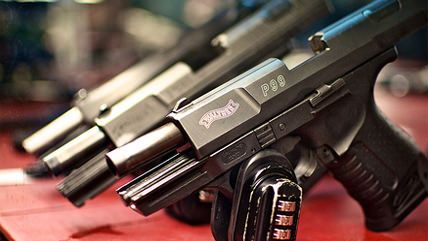California Cops Become Mind Readers, Seize Your Guns
The new law is less about the firearms and more about trying to identify people who might be too dangerous to own them.

SACRAMENTO — Gun-control efforts often center on hardware, such as limiting or banning the ownership of particular firearms and ammunition. But in California this year, the most significant new gun-related law is less about the guns and more about identifying people who might be too dangerous to own them.
A.B. 1014, which goes into effect Jan. 1, 2016, creates a Gun Violence Restraining Order that allows people who suspect a family member is mentally unstable or dangerous to get a court order forbidding that person from owning weaponry and ammo. The state legislature passed the bill in reaction to the tragic mass murder in May at Isla Vista.
"This year's mass shooting near Santa Barbara left six dead and 13 wounded," said U.S. Sen. Dianne Feinstein (D), following the governor's bill signing. "The gunman's mother saw signs that her son was a danger, yet she was powerless to prevent him from possessing firearms — even temporarily."
At first blush, the focus on people seems likely to build more consensus than a focus on hardware, given that gun-control opponents have long argued — as the cliché goes — that guns don't kill people, but people kill people. But nothing ever is simple.
Past efforts to, say, outlaw so-called assault rifles opened a can of worms, as it was far more difficult than expected to define the exact type of gun that fit the ban. Not surprisingly, it's even more difficult to describe human beings who might be dangerous — and to craft the right policies to stop them — than it is to detail the magazines and style of an outlawed weapon.
The Isla Vista murderer killed his first three victims by stabbing them, which reinforces a point made by John R. Lott Jr., author of the 1998 book, More Guns, Less Crime and president of the Crime Prevention Research Center: "Why not commit these individuals? You can't stop them from getting weapons."
Mass killers prepare their crimes for many months and even years in advance, he said in an interview Friday, and they rarely are deterred by legalities. In a New York Post column he coauthored, Lott also argues that psychiatric professionals aren't good at predicting behavior: "What seems like obvious telltale signs in retrospect are not so obvious before the attack, even to the experts. … Extremely few of those with mental illness go on to become killers."
Some of the law's supporters argue it won't do as much to protect against killing sprees as it will to keep guns away from suicidal people. Suicides might be easier to predict than mass shootings, but Lott's point also is valid about there already being a good remedy for these situations. Family members can petition a judge to have a dangerous or suicidal person committed for 72 hours to an institution for psychiatric evaluation.
The main problem critics have with the new law involves due process. A gun owner may be deprived of a constitutional right for a year based on the claims of even distant relatives and using a lower "reasonable" standard rather than the "clear and convincing" standard. Psychiatrists may not be great at predicting violent behavior, but the law takes them out of the process and leaves the decision in the hands of police officers and judges, who probably will err on the side of caution.
The person losing his or her rights wouldn't necessarily be at the hearing where the decision is made, but the law's supporters say that it has plenty of due-process protections because it allows the person to later challenge the court order. That can be time-consuming and takes place after the person has already lost gun rights, though.
People who would be slapped with this Gun Violence Restraining Order who already own guns would have their names placed in the Armed and Prohibited Persons System. Using that database, the California Department of Justice sends agents to confiscate the firearms of people on the list — i.e., those who no longer legally are allowed to own them. But the system is backlogged and riddled with errors, with inaccuracy rates as high as 40 percent or more.
It gets back to the Minority Report issue, referring to the 2002 science-fiction movie in which a Department of PreCrime arrests murderers before they commit the crime. While the fictional department relies on clairvoyants, real-world California policy makers must rely on less-reliable sources and databases. The new law is an interesting departure from the "ban the gun" approach, but there are plenty of reasons to be skeptical.




Show Comments (64)